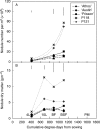Genetic variability in nodulation and root growth affects nitrogen fixation and accumulation in pea
- PMID: 17670753
- PMCID: PMC2533614
- DOI: 10.1093/aob/mcm147
Genetic variability in nodulation and root growth affects nitrogen fixation and accumulation in pea
Abstract
Background and aims: Legume nitrogen is derived from two different sources, symbiotically fixed atmospheric N(2) and soil N. The effect of genetic variability of root and nodule establishment on N acquisition and seed protein yield was investigated under field conditions in pea (Pisum sativum). In addition, these parameters were related to the variability in preference for rhizobial genotypes.
Methods: Five different spring pea lines (two hypernodulating mutants and three cultivars), previously identified in artificial conditions as contrasted for both root and nodule development, were characterized under field conditions. Root and nodule establishment was examined from the four-leaf stage up to the beginning of seed filling and was related to the patterns of shoot dry matter and nitrogen accumulation. The genetic structure of rhizobial populations associated with the pea lines was obtained by analysis of nodule samples. The fraction of nitrogen derived from symbiotic fixation was estimated at the beginning of seed filling and at physiological maturity, when seed protein content and yield were determined.
Key results: The hypernodulating mutants established nodules earlier and maintained them longer than was the case for the three cultivars, whereas their root development and nitrogen accumulation were lower. The seed protein yield was higher in 'Athos' and 'Austin', the two cultivars with increased root development, consistent with their higher N absorption during seed filling.
Conclusion: The hypernodulating mutants did not accumulate more nitrogen, probably due to the C cost for nodulation being higher than for root development. Enhancing exogenous nitrogen supply at the end of the growth cycle, by increasing the potential for root N uptake from soil, seems a good option for improving pea seed filling.
Figures



References
-
- Ali-Khan ST, Snoad B. Root and shoot development in peas. I. Variability in seven root and shoot characters of seedlings. Annals of Applied Biology. 1977;85:131–136.
-
- Ballard RA, Charman N, McInnes A, Davidson JA. Size, symbiotic effectiveness and genetic diversity of field pea rhizobia (Rhizobium leguminosarum bv. viciae) populations in South Australian soils. Soil Biology and Biochemistry. 2004;36:1347–1355.
-
- Baudoin E, Benizri E, Guckert A. Metabolic fingerprint of microbial communities from distinct maize rhizosphere compartments. European Journal of Soil Biology. 2001;37:85–93.
-
- Biedermannova E, Novak K, Vondrys J. Pea mutant Risnod27 as reference line for field assessment of impact of symbiotic nitrogen fixation. Journal of Plant Nutrition. 2002;25:2051–2066.
-
- Caetano-Anolles G, Gresshoff PM. Plant genetic control of nodulation. Annual Review of Microbiology. 1991;45:345–382. - PubMed

